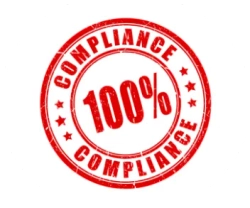The aim across construction projects is to create quality buildings according to code. This ensures structural integrity and long-lasting safety for building occupants. In the case of fire safety design, when using tools like intumescent paint to achieve the intended fire rating, it is vital to work with products that are properly listed and have full compliance.
Table of Contents:
- •What is AC23?
- •The difference between ESR and ESL
- •The role of ESR and ESL in confirming product fire resistance requirements
- •Ensure an intumescent paint is fully compliant
- •Compatibility between intumescent paint and building components
- •What are the installation requirements for intumescent paint?
- •Common misconceptions related to ESRs, ESLs, and intumescent paint
- •Mitigating risks between a mismatch in fire resistance ratings and the performance capabilities
In order to be regarded as fully compliant, a coating must undergo a series of extensive tests including flame spread tests, and a series of 16 environmental tests to ensure that the coating can withstand a range of circumstances and maintain effectiveness over time across conditions.
A “fully compliant” material will have undergone and passed the AC23 (Acceptance Criteria) and this can be referenced and verified in a testing report.

The difference between ESR and ESL:
ESR (Evaluation Service Report) is the evaluation report provided by ICC when a material has met the AC23 acceptance criteria which includes a series of extensive environmental exposure tests, as well as a flame spread test.
Meanwhile, ESL (Evaluation Service Listing) reports provide additional data for a product as it applies to different substrates. ESL reports are designed for testing that is not included in the ESR, for example how the same product might perform on drywall.
When referencing ESL reports it is important to link back to ESR so that industry professionals can examine the primary test for reference and ensure the product intended for their project is code compliant.
When selecting intumescent paint for a construction project it is important to differentiate between the roles of ESR and ESL as they pertain to fire resistance rating. Verifying that intumescent paint aligns with the specifications outlined in a document can be challenging.
ESR and ESL reports act as a form of communication to construction professionals looking for code-compliant materials. An informed professional can recognize that an ESR rating indicates a product has gone through rigorous official testing that sets it aside from many competitors who have not formally met AC23.

In previous practice coatings could not receive any ESL listings without first passing the ESR acceptance criteria. This was an easy way to ensure that any intumescent paint incorporated in a building design was fully compliant. However, overtime rules have shifted, and it is no longer mandatory to obtain an ESR before an ESL.
This practice can cause false confidence in building professionals who may assume the presence of an ESL indicates the presence of an ESR by default. In order to ensure that an intumescent coating is fully compliant with any ESLs included, building professionals should be sure to reference the initial ESR as well.
ESR is an indication that a coating is fully compliant. Any coating with ESL reports, but no ESR does not meet the necessary criteria.
It is important to verify these reports before incorporating a product in a design as the difference of the mismatch between the ratings specified on the ESL and performance capabilities are huge. Such a misunderstanding may compromise a building's safety in the long run.
Not every building component should be treated similarly in the task of fire protection.
As materials are ranged in shape and composition, the compatibility between intumescent paint and various building components should be acknowledged by the construction professionals involved in a project.
Different components will require different approaches to fire proofing. A two hour rating for one type of beam will have different requirements from a beam with a different shape, for example an N series beam vs a S series beam. As such when taking steps to fireproof it is important to speak with a technical expert that can help your team figure out the proper approach to application per building component.
FlameOFF Coatings sales team offers extensive and detailed technical support. Contact us any time with specific compatibility questions regarding our product Fire Barrier Paint.
Use our steel coverage calculator to calculate wet film thickness.
Some construction professionals and paint applicators might wonder if there are any installation or application requirements outlined in the ESR or ESL regarding intumescent paint that are necessary in order to achieve full code compliance.
Your team will be relieved to know that there are no such requirements outlined by ICC to achieve full compliance.
The notion that applicators need to be certified to apply intumescent coatings to achieve a proper fire rating is a myth. Application and code compliance exist in two separate ballparks. To ensure the application of intumescent coating is performed adequately, applicators should carefully review product manuals, but no formal certification is necessary to use such products.
However, proper application is still vital to the fire safety process, as such FlameOFF Coatings offers a self led, free and easy certification program. This training program ensures that individuals who lack experience in working with intumescent coatings don’t step into the process blind.
Look into becoming a certified FlameOFF Applicator to prepare for projects.
- One of the biggest misconceptions construction professionals should be aware of regarding code compliance is the misunderstanding that the presence of ESL testing does not immediately guarantee the presence of ESR.
- Industry professionals need to be aware of the difference between ESR and ESL in order to make informed decisions regarding code compliance and the products they choose to incorporate in their projects.
- This distinction can be confusing and misleading to professionals navigating the market. However, the differences are stark as in order to obtain an ESR a product will undergo rigorous expensive testing, meanwhile an ESL testing is not nearly as complicated or strenuous.
FlameOFF Coatings sales team offers extensive and detailed technical support. Contact us any time with specific compatibility questions regarding our product Fire Barrier Paint.
Use our steel coverage calculator to calculate wet film thickness.

It is not unheard of for certain coating manufacturers to misconstrue their protective coatings performance capabilities in order to make sales.
There are various methods in which people try to work around proper testing in order to save money, however, this is in violation of law and ethics. Failure to meet the required fire rating can lead to severe property damage as well as put the lives of building occupants at risk.
The best way to mitigate these mismatches in construction projects is to be an informed consumer. Do not rush the process of fire rating a design, remain conscious of the importance of properly fire rating your building, and incorporate trustworthy and reliable fireproofing materials.
Products that are fully compliant will be able to provide all necessary reports to reinforce claims of code compliance. Communicate with the technical sales departments of companies and ask for an ESR report to confirm coating compliance.
In the case of mismatched information between technical data sheets and advice from a sales department, data reports are king. Pay attention to what reports and datasheets affirm about a product as to obtain listings a product must go through thorough expensive testing processes making this the most reliable source of information.
It is similarly important to keep in mind that proper application of a product is just as important as meeting compliance. Do not exceed the noted DFT (dry film thickness) that a product has been tested for.

When looking for a code compliant intumescent paint as a fire safety approach, FlameOFF Coatings Fire Barrier Paint is a fully compliant coating that you can confidently incorporate into your fire safety design.
This innovative intumescent coating offers 1-2 hours of fire protection on a range of substrates. A water-based, eco-friendly coating that provides an aesthetically pleasing eggshell finish has undergone rigorous testing to ensure that your projects will be properly protected.
Talk to our informed technical sales department before or after any purchase with questions on testing and application: